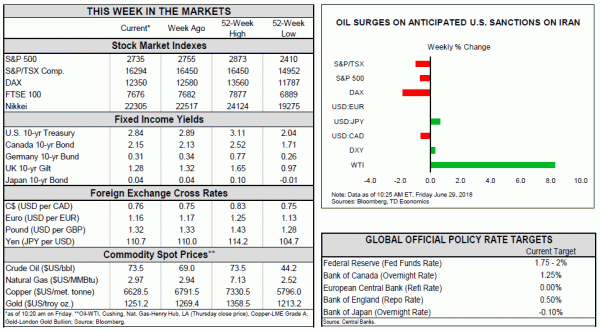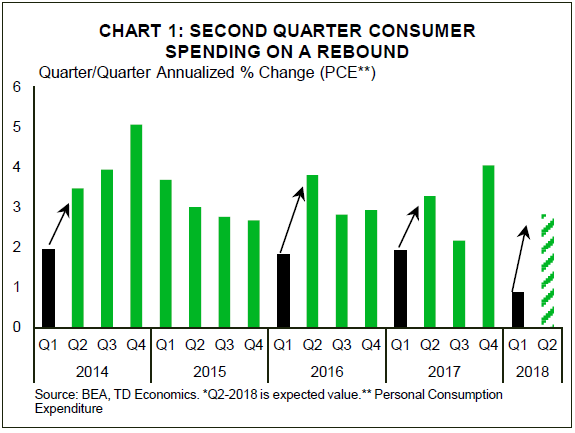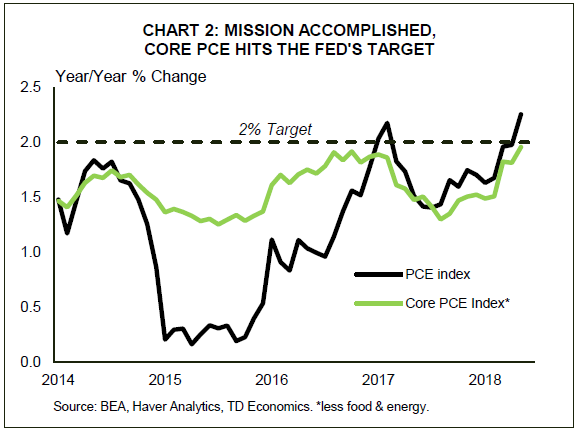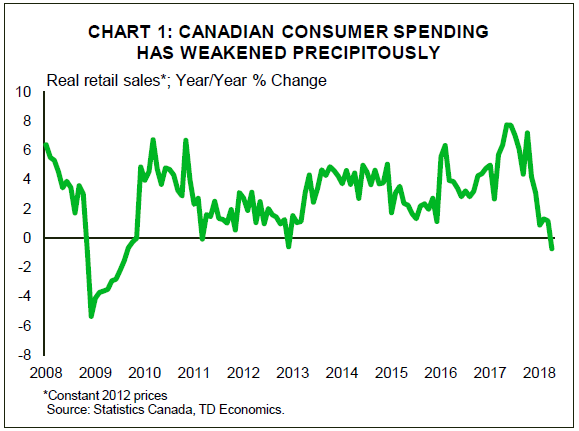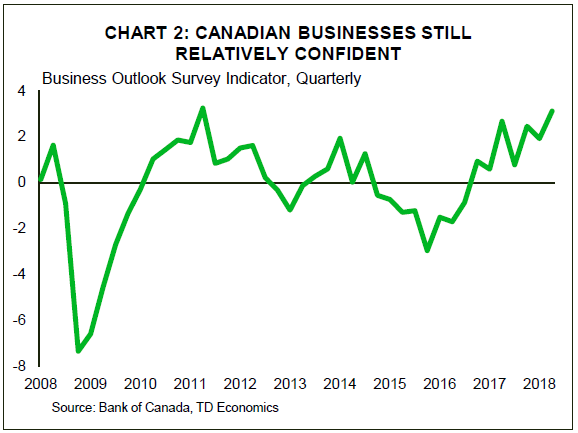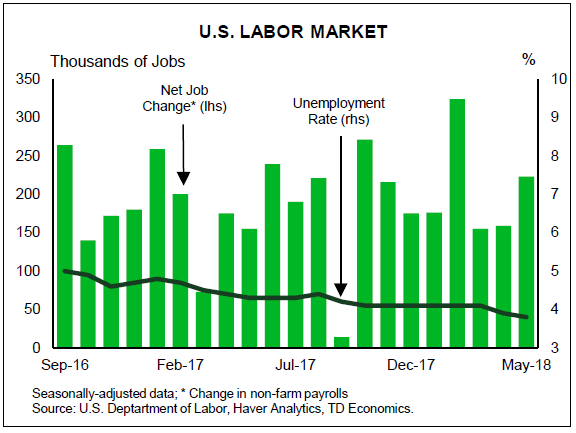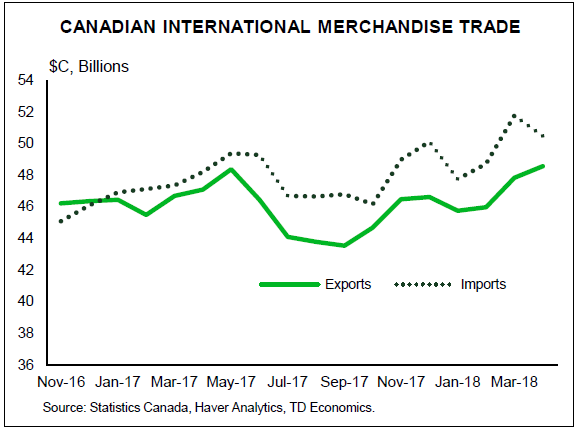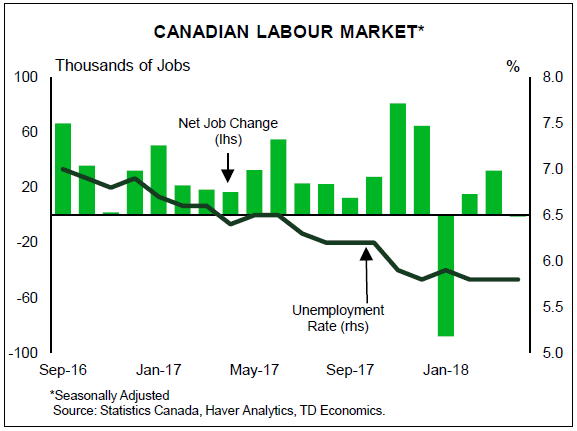U.S. Highlights
- The BEA’s third estimate of Q1 real GDP downgraded growth slightly to 2.0%, from 2.2% previously. May data did show flat real personal spending, but strength in March and April still set Q2 consumption up for a decent rebound.
- The Fed’s preferred measure of inflation, core PCE, hit its 2% target in May. This supports our forecast for continued gradual monetary policy tightening, as the focus shifts to containing upside risks.
- Shifting headlines on trade were a key driver of stock market activity. Foreign policy also got in on the action, with crude prices surging on the anticipation of tougher U.S. sanctions on Iran.
Canadian Highlights
- The Canadian economy, beset by headwinds, still managed to grow in April with real GDP rising 0.1%.
- Canadian firm sentiment also remained solid, according to the Bank of Canada’s Business Outlook Survey.
- The Bank of Canada is focusing on clarity, but the economic data and trade risks are anything but. The Bank’s July 11th rate decision looks to be a hike, but the path thereafter is anything but clear.
U.S. – BULLSEYE!
The U.S. economy slowed more than previously believed in the first quarter of 2018, with growth coming in at 2% ann. according to the BEA’s third estimate, down 0.2 percentage points from the second estimate. The downward revision was largely due to weaker consumer spending, while softer inventory investment also played a part. New data out this morning on personal income and outlays reinforce the notion that the soft start to the year was temporary. Supported by a healthy 0.4% m/m gain in nominal personal incomes, nominal spending rose a respectable 0.2% in May. But given inflation, consumption was flat in real terms. Strength in March and April still set Q2 consumer spending – currently tracking just shy of 3%, slightly below our forecast (Chart 1) – up for a rebound. We continue to expect the economy to grow by some 4% in Q2 given widespread strength in other components.
Consumer spending should continue to follow a decent 2.5% growth path in the second half of 2018, bolstered by a tight labor market and tax cuts, which will continue to support incomes. The latter will feature favorably for housing demand, even as interest rates rise. But a lack of inventory will constrict the sales pace. On this front, pending home sales – a solid gauge of near-term activity – retreated in May, marking the second consecutive monthly decline and weakening a previously improving trend.
Perhaps the most striking element from this morning’s report was inflation data. The headline PCE index ticked higher to 2.3% y/y, while core PCE (the Fed’s preferred measure of inflation) hit the bullseye of 2% for the first time in six years (Chart 2). These developments support our view for the Fed to continue raising rates gradually, with two more hikes expected for 2018. The focus now shifts from below-target-inflation to containing the upside risks.
With little else in the way of primary data, shifting headlines on trade remained an important driver of stock market activity. Markets opened lower on Monday after indications that the U.S. planned new curbs on Chinese investment in U.S. tech firms. Foreign policy also got in on the action, with crude prices surging on the anticipation of tougher U.S. sanctions on Iran. The rollercoaster ride in equities continued, with the President seemingly taking a softer stance on Chinese tech investment, but then hinting at the possibility of protectionist action on autos.
Ultimately, trade spats with a number of important trading partners risks siphoning away much of the economic boost from fiscal stimulus by way of higher consumer prices, reduced exports, supply chain disruptions, and by denting consumer and business confidence. Under the presumption that the tougher trade rhetoric is simply a negotiating tactic, there is still hope that common sense will prevail, and tensions will de-escalate. The risk, however, is that once the wheels have been set in motion, tensions can quickly escalate to a full-out trade war. China, Mexico and the EU have already retaliated to some degree, while Canada is announcing a detailed list of U.S. products to be slapped with retaliatory tariffs at the time of writing, which will take effect over the weekend. The U.S. may up the ante, further reinforcing the negative feedback loop.
Canada – Clear As A Cloudy Day
Summer vacation is here, but for those of us trying to parse out the next move from the Bank of Canada, the rest and relaxation will have to wait. A July rate hike has been long expected, but a turn south in (some) economic data and a worsening in the trade relationship with the U.S. has led to doubts about its likelihood.
This week, Governor Poloz gave a speech entitled “Let Me be Clear,” outlining the Bank’s communication strategy. The focus on communication comes at a time when the Canadian economy faces a heightened level of uncertainty. As clear as the Bank of Canada tries to be, its crystal ball is more cloudy than usual at the moment. The governor’s response is to move away from “forward guidance” and toward data dependence. So, what does the economic data say about the case for a rate hike?
First, we must recognize the negatives. Consumer spending appears to have weakened fairly dramatically over the past few months. While some of this softness may reflect unseasonable weather, the deceleration is marked (Chart 1). The slowdown is echoed in credit growth, not just for mortgages, but also credit cards and other consumer credit lending. Inflation also disappointed in May, corroborating the seeming loss in momentum.
At the same time that domestic demand is showing softness, export growth has, with the exception of April, been disappointing. The weakness on the export front has come even without the imposition of tariffs on steel and aluminum and counter-tariffs on U.S. goods. In his speech, Poloz noted that the trade dispute will “figure prominently” in the Bank’s next decision and is likely to lead to a modest downgrade in the Bank’s economic outlook.
On the other hand, several developments have been positive, especially relative to the Bank’s previous forecast in April. Oil prices have moved higher and are about US$10 a barrel above the Bank of Canada’s earlier expectations. Higher oil prices may not have the benefit they had in the past given pipeline constraints and trade uncertainty, but they are still, on balance, positive.
Similarly, the housing market, has shown signs of stabilization. Some markets such as Montreal and Ottawa have even shown decent positive momentum. In the job market, wage growth has accelerated and jobs have tilted toward full-time. Finally, the boost to U.S. growth from fiscal stimulus is playing out as expected, with growth in domestic demand in the second quarter coming in ahead of expectations.
Despite Governor Poloz’s focus on clarity, the Bank’s next decision is anything but. On balance, the economic data, while softening, have not moved materially off the Bank’s previous projections. Indeed, after today’s April GDP report, which eked out a modest 0.1% gain, we anticipate the second quarter to come in around 2.4%, roughly in line with the Bank’s 2.5% projection. With the business outlook survey suggesting a good degree of confidence among Canadian firms (Chart 2), we expect it to be sufficient for the Bank to lift its key lending rate in July. Still, given a more cautious outlook and ongoing threat of escalating trade wars, we suspect it will be some time before we see another hike.
U.S.: Upcoming Key Economic Releases
U.S. Employment – June
- Release Date: July 6, 2018
- Previous: 223k, unemployment rate: 3.8%
- TD Forecast: 180k, unemployment rate: 3.8%
- Consensus: 200k, unemployment rate: 3.8%
We lean toward a modest pullback in June nonfarm payroll gains of 180k vs 223k in May. This is mainly on account of a moderation in private services in line with the past retreat in the ISM non-manufacturing jobs index. On the goods side, we expect solid performance consistent with the robust trend across regional factory surveys and a higher oil rig count.
We expect an unchanged unemployment rate of 3.8%, with risks skewed to the upside on a rebound in labor force participation. We look for average hourly earnings to rise 0.3% m/m, leading the y/y pace to 2.8% y/y. Risks are to the upside for the m/m print, but we can’t rule out downward revisions which temper any upside to the y/y pace.
Canada: Upcoming Key Economic Releases
Canadian International Trade – May
- Release Date: July 6, 2018
- Previous: -$1.90bn
- TD Forecast: -$2.60bn
- Consensus: N/A
TD looks for the international trade deficit to widen to $2.6bn in May on a rebound in import activity. Exports should see little change as weakness in the non-energy component offsets stronger energy exports. Metals should benefit from some frontloading of steel/aluminum exports ahead of tariffs on June 1st but we see limited upside after a large increase in the previous month. Energy exports will provide the main source of strength amid a surge in crude oil prices while advance US trade data implies soft autos. Looking ahead, CAD depreciation should provide a sizeable tailwind to exports over the coming months though steel/aluminum tariffs will start to weigh on exports and imports in June and July, respectively.
Canadian Employment – June
- Release Date: July 6, 2018
- Previous: -7.5k, unemployment rate: 5.8%
- TD Forecast: 10k, unemployment rate: 5.8%
- Consensus: N/A
TD expects job growth to rebound to 10k in June, which would be sufficient to recover the 7.5k jobs lost in May while extending the relatively soft pace that has persisted since January. Job growth should be led by full time positions, which would add a modestly upbeat tone to the report, while part time employment should underperform after a 20k gain in May. Wage growth should remain unchanged at 3.9% y/y for permanent employees with risks tilted to the upside on the minimum wage hike in BC. However, the magnitude of the hike ($11.35 to $12.65) and relative size of the labour market imply a lesser impact on the national average than similar policies in Alberta and Ontario. Meanwhile, the unemployment rate should hold at 5.8% for the fifth consecutive month absent a rebound in labour force participation.




